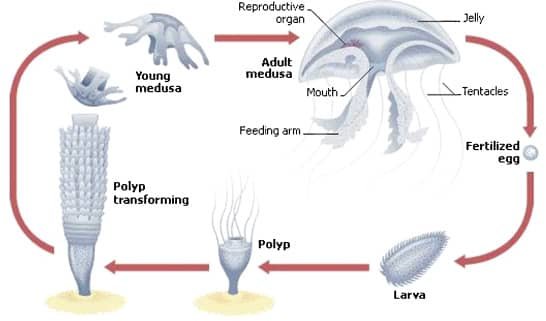
Jellyfish, including the moon jellyfish, might seem simple, but their reproduction is quite complex. Imagine them like tiny, drifting balloons filled with secrets about life under the sea. They have a unique way of reproducing that sets them apart from many other aquatic creatures. Instead of laying eggs in the open water like fish do, moon jellyfish have a two-part life cycle that includes both sexual and asexual reproduction. This dual approach gives them a significant advantage when it comes to survival and thriving in their environment.
The Life Cycle of the Moon Jellyfish
To truly appreciate how moon jellyfish breed, it helps to understand their *life cycle*. This cycle consists of several stages: the polyp stage, the ephyra stage, and the medusa stage. Let’s break these down.
The Polyp Stage
The journey of a moon jellyfish begins as a tiny polyp, which resembles a small, individual coral. They attach themselves to a hard surface underwater, like rocks or shells, and can live for several years. During this stage, polyps reproduce asexually by budding. This means they can create clones of themselves, which allows them to grow colonies. It’s like having a group of friends all living together and helping each other thrive!
The Ephyra Stage
Once conditions are right, the polyp will release small jellyfish called ephyra into the water. Think of ephyra as the teenage version of the moon jellyfish. They’re still developing, and over time, ephyra grow into the familiar jellyfish shape we recognize. This stage usually lasts a few weeks to a couple of months, depending on environmental conditions. It’s during this transition that ephyra develop their beautiful, umbrella-shaped bells and trailing tentacles.
The Medusa Stage
Now we reach the popular medusa stage—the fully-formed moon jellyfish! With their translucent bodies, they can grow several inches across. In this stage, moon jellyfish are ready to reproduce. They can engage in both sexual and asexual reproduction, giving them flexibility in their life cycle. They typically live for about six months to a year. While they don’t have a brain, they possess a simple nervous system, allowing them to respond to their environment and find food.
How Moon Jellyfish Reproduce
You might be curious about how moon jellyfish actually reproduce. They do it in a couple of different ways, creating a fascinating dance of life under the waves.
Sexual Reproduction
During the sexual reproduction phase, male moon jellyfish release sperm into the water. The sperm then finds and fertilizes the eggs, which are usually contained within the bell of the female jellyfish. Once fertilized, the eggs develop into larvae and eventually settle on the ocean floor as polyps, continuing the cycle. This method can be thought of as a grand dance of chance, where the successful meeting of sperm and eggs creates new life.
Asexual Reproduction
On the flip side, moon jellyfish can also reproduce asexually through budding during their polyp stage. In this process, a new jellyfish grows directly from the parent polyp, essentially as a clone. This method is somewhat like how plants can grow new plants from cuttings. Asexual reproduction allows them to rapidly increase their population size and colonize areas quickly, especially in environments where conditions are favorable.
The Role of Environmental Conditions
Environmental factors play a significant role in the reproduction of moon jellyfish. Here are a few aspects to consider:
- Temperature: Moon jellyfish typically breed in warmer waters. The right temperature helps trigger the spawning process, giving a boost to their reproductive activities.
- Food Availability: A plentiful food supply, mainly plankton, encourages jellyfish to grow and reproduce. When food is scarce, they may postpone breeding until conditions improve.
- Salinity: The salinity of the water can impact reproduction as well. Moon jellyfish thrive in brackish waters, and extreme changes in salinity can affect their breeding success.
You might be wondering how all these factors interconnect. Imagine you’re planning a party; you need a good venue (the right water conditions), plenty of snacks (food availability), and the right time (temperature). Without these components, the celebration—or in this case, reproduction—just can’t happen as effectively.
Population Dynamics and Ecology
The reproduction of moon jellyfish has broader implications for the marine ecosystem. As they reproduce and thrive, they can affect local fish populations and the food chain. Here’s how their presence can be felt:
Predator-Prey Relationships
Moon jellyfish are often prey for larger creatures like sea turtles and some fish species. When their populations surge, it can provide a rich food source for these predators. However, an overabundance of jellyfish can also disrupt the balance of marine life, leading to declines in fish populations.
Impact on Fishing Industries
Interestingly, moon jellyfish can affect commercial fishing. When their numbers skyrocket, they can clog fishing nets and interfere with fish populations. Fishermen may find it challenging to catch the fish they’re targeting, leading to economic impacts. This balance between jellyfish and fish populations is crucial for maintaining healthy marine ecosystems and sustaining fishing industries.
The breeding and reproduction of moon jellyfish are far more intricate than one might assume at first glance. From their remarkable life cycle to their dual methods of reproduction, moon jellyfish showcase the wonders of marine life. Understanding these processes not only satisfies our curiosity but also highlights the importance of these creatures in ocean ecosystems.
As we continue to explore and study the delicate balance of life in our oceans, let’s remember that even the simplest-looking creatures, like the moon jellyfish, have complex lives filled with fascinating stories. Whether you’re a marine biologist or just someone who enjoys the beach, knowing more about these jellyfish adds a deeper layer of appreciation for the natural world around us.
